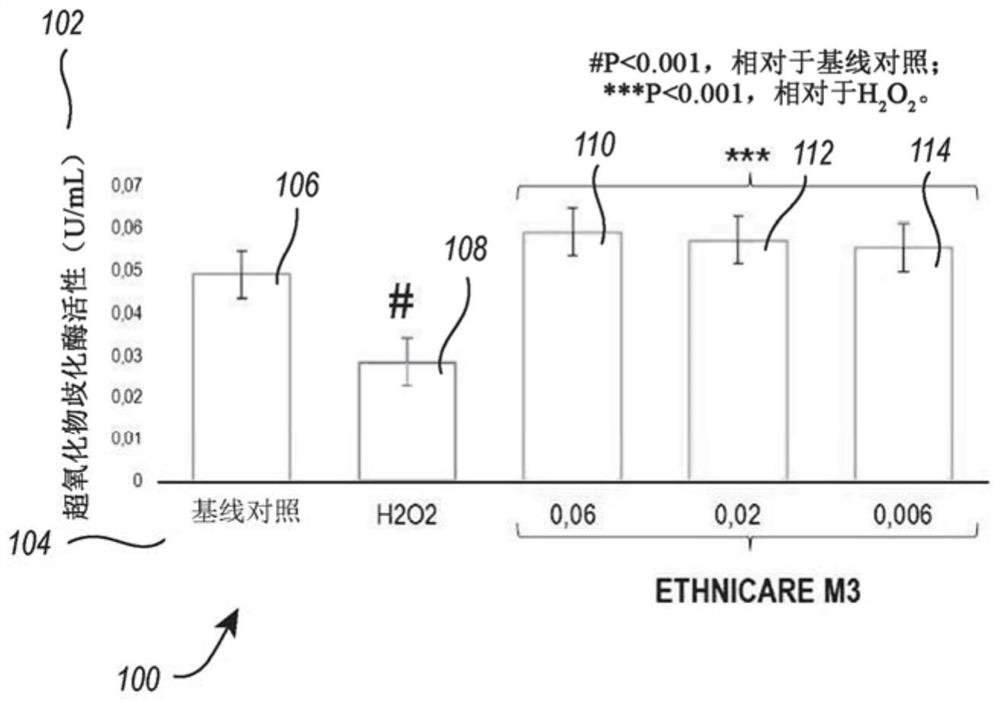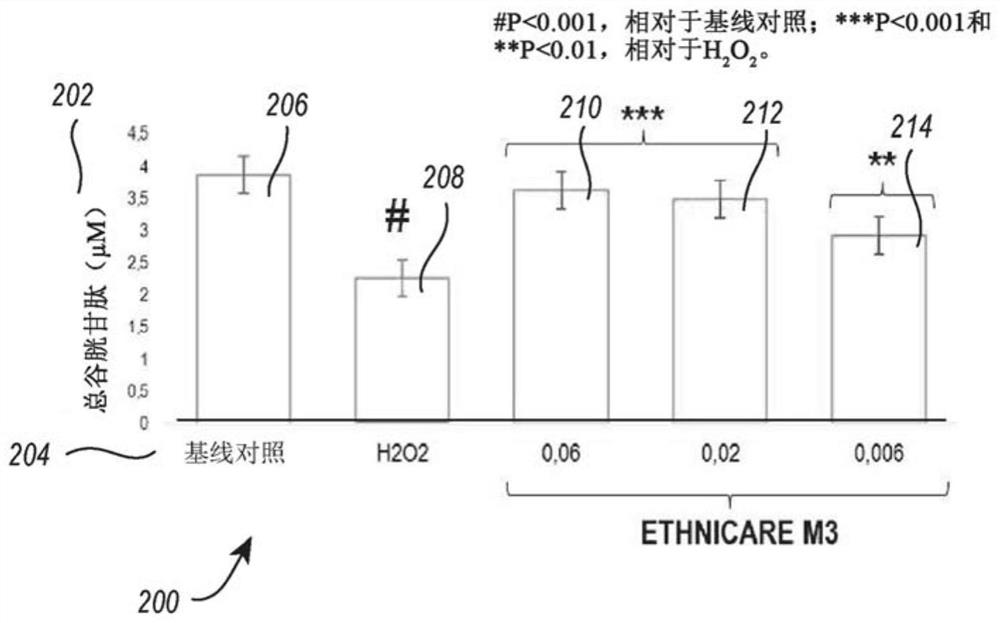Natural skin care compositions and methods for treating oxidative stress and restoring skin health
An oxidative stress, composition technology, used in skin care preparations, drug combinations, skin diseases, etc.
- Summary
- Abstract
- Description
- Claims
- Application Information
AI Technical Summary
Problems solved by technology
Method used
Image
Examples
example 1
[0110] A mixture of bilberry + Buddleia japonica + Bilberry leaf extracts was evaluated via an enzymatic assay in lysate cells (hereinafter, " M3") for total glutathione quantification and superoxide dismutase (SOD) activity. Multiscan GO units available from Thermo Fisher Scientific of Waltham, MA (Thermo Fisher Scientific of Waltham, MA) were used. Absorbance readings were taken at 410nm for total glutathione and 450nm for SOD on a chromatograph. Quantitative values were normalized by total protein in the sample using the Bradford technique as described in Analytical Biochemistry (Anal. Biochem), 72:248-254.
[0111] Seed primary human fibroblasts in 75cm 2 flask, culture, and incubator at 37 °C in 5% CO 2 Amplified in the presence. After reaching confluency, cells were seeded in well plates and exposed to hydrogen peroxide and quantified mediator.
[0112] For statistical evaluation, an analysis of variance (ANOVA) test was used to initially measure the variance of t...
example 2
[0119] In this instance, the evaluation Photoprotection of M3 against visible light in the range 400-700nm, as long-term exposure to visible light has been shown to induce oxidative stress, which may contribute to unwanted skin pigmentation (dark spots), inflammation and oxidative photoaging. Visible blue radiation (440-485nm), also known as "blue light," is able to penetrate deeper into the skin than UVA and UVB light, all the way to the dermis where collagen and elastin are located. In addition to the sun, electronic devices such as smartphones and computer screens emit blue light, which most people are exposed to in large amounts on a daily basis. The potential negative photoaging consequences of such exposures on the skin are troubling.
[0120] In order to evaluate its blocking ability, the Films of M3 were applied to Helioplate HD6 substrates from HelioScreen Labs. Transmission spectra were then obtained using a UV 2450 Shimadzu spectrophotometer (ISR-240A) with an ...
example 3
[0123] The leaf extracts bilberry and berry were evaluated for their ability to prevent the formation of undesired thymidine dimers when exposed to UVB radiation. When the skin is exposed to UVB radiation, the thymidine bases in DNA can absorb the UVB radiation to form thymidine dimers (also known as thymine dimers) in the DNA, complicating the cells' efforts to replicate DNA and function properly change. In this experiment, an in vitro thymidine dimer assay was performed using a skin model consisting of normal human-derived epidermal keratinocytes cultured to form a multilayer model of human epidermis.
[0124] One group of tissues was treated with Chilean berry leaf extract for seven days, another group of tissues was tested with bilberry leaf extract for seven days, and a third group was not treated. All three tissue groups were then exposed to 300mJ / cm 2 of UVB radiation. DNA was then extracted and analyzed for thymidine dimer content.
[0125] The DNA is then immobili...
PUM
| Property | Measurement | Unit |
|---|---|---|
| transmittivity | aaaaa | aaaaa |
Abstract
Description
Claims
Application Information
 Login to View More
Login to View More - R&D
- Intellectual Property
- Life Sciences
- Materials
- Tech Scout
- Unparalleled Data Quality
- Higher Quality Content
- 60% Fewer Hallucinations
Browse by: Latest US Patents, China's latest patents, Technical Efficacy Thesaurus, Application Domain, Technology Topic, Popular Technical Reports.
© 2025 PatSnap. All rights reserved.Legal|Privacy policy|Modern Slavery Act Transparency Statement|Sitemap|About US| Contact US: help@patsnap.com



